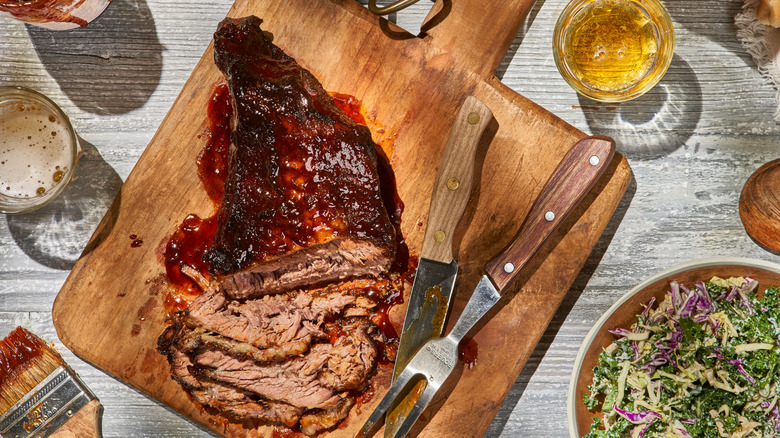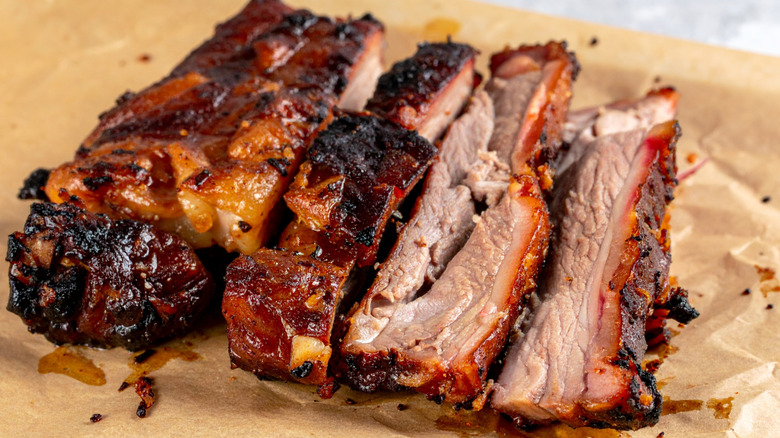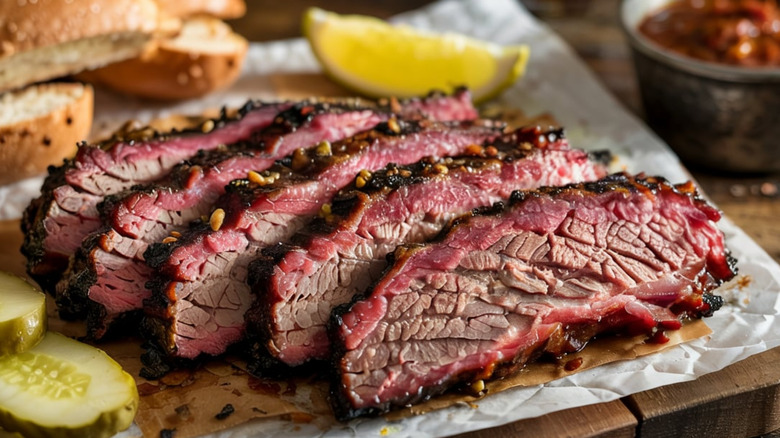Brisket Point Vs Flat: What's The Difference Between Cuts?
Brisket is the undisputed king of the barbecue, the crème de la crème of any Southern-style cookout. This sturdy beef cut is composed of two main sections: the point and the flat, which together form a whole brisket. The dual-muscle structure makes brisket notoriously tricky to cook to perfection, and there are several common mistakes that can ruin it. Differences in fat content, flavor, and texture mean that each piece cooks at different rates. On top of this, they also have unique intended culinary uses for a barbecue spread. Understanding these differences is essential for mastering brisket and turning out a truly standout barbecue.
To break down what sets the point and flat apart, Food Republic consulted Nicole Johnson, owner and recipe developer of Or Whatever You Do. According to Johnson, "Use the point when you want that rich, shredded, fall-apart texture (like for burnt ends), and the flat when you need cleaner slices for sandwiches or a [barbecue] platter." Both cuts boast a bold, beefy flavor, but their textures tell a different story. The point is the fattier, more flavorful end, packed with marbling that melts into juicy, tender bites. The flat, on the other hand, is leaner and more uniform. This is what makes it ideal for slicing and stacking sky-high on a sandwich or plating neatly on a barbecue spread.
What is the brisket point?
The brisket point, also known as the deckle or the second cut, comes from the cow's ribcage area and is the fatty, well-marbled section of the brisket. Compared to the flat, the point contains significantly more intramuscular fat and connective tissue, which break down during cooking into gelatin, creating a rich, concentrated beefy flavor. "The point has more fat marbled throughout, more connective tissue, and more flavor, but it's also tougher and shrinks more when cooked," recipe developer Nicole Johnson told us.
Because of its high fat content and thick shape, the point is especially well-suited for burnt ends — crispy, caramelized chunks of brisket, which are beloved among barbecue enthusiasts. The point also performs well in braising, where its richness and properties suited for longer cooking times allow for deeper flavor development. Compared to the flat, Johnson told us, "For braising, either works, but the point gives you more flavor and richness." While the point may yield smaller portions due to its shrinkage during cooking, its bold flavors and melt-in-your-mouth texture make it a favorite for low-and-slow cooked dishes. The fat content is also why many seasoned barbecue experts smoke the point and flat together despite textural differences, as the fattier point helps keep the leaner flat moist and tender during cooking. As for the best wood to use during smoking, we recommend Texan-style oak wood.
What is the brisket flat?
The brisket flat, often referred to as the "first cut", is the leaner, rectangular section of the brisket and comes from the area closer to the cow's breastbone. It is noticeably larger and thinner than the point, with significantly less intramuscular fat. While it doesn't have the same rich marbling as the point, its consistent shape and texture make it a favourite for slicing and presentation.
"The flat is leaner and more uniform, which makes it easier to slice and better suited for presentation," Nicole Johnson explained. This uniformity also makes it more forgiving when cooking, especially for amateur home smokers. Unlike the point, which can be texturally uneven, making it more challenging to cook evenly on a smoker, the flat lies flatter and allows for more consistent cooking. As Johnson told us, "If you're [smoking] one cut, the flat is easier to handle and better for slicing." This clean, structured grain also makes it ideal for dishes where presentation matters, like sliced brisket platters or stacked sandwiches.
Though it is leaner than the point, when cooked low-and-slow, the flat becomes tender and juicy, developing a beautiful bark on the outside and soft, buttery slices on the inside. Overall, its versatility, ease of handling, and cleaner presentation are some of the reasons why the flat is a staple on barbecue menus across the country and is generally more common to find in supermarkets.



